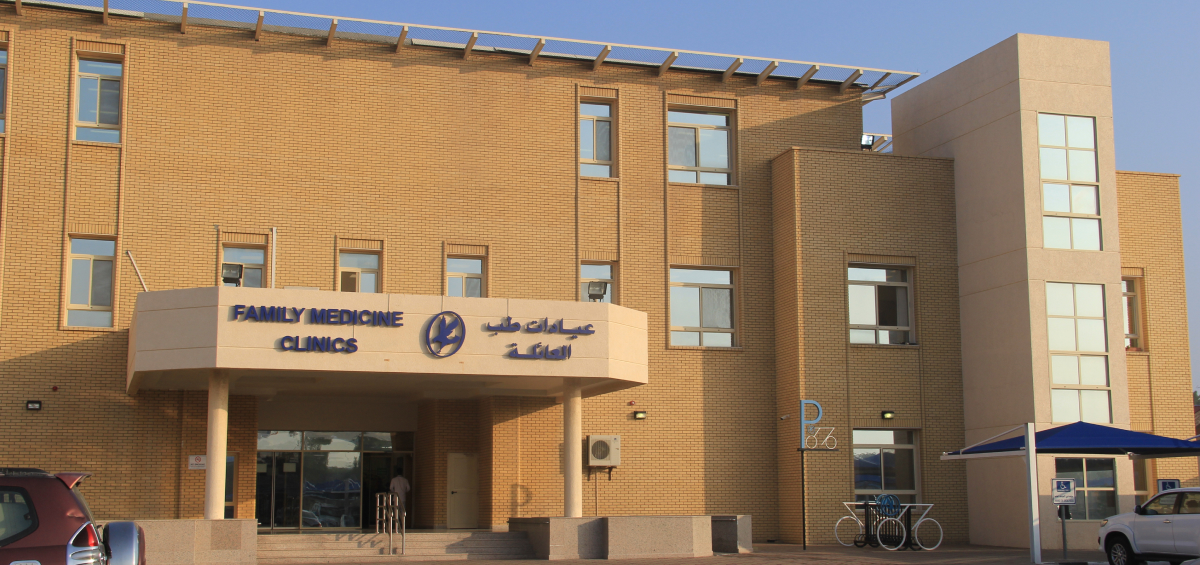
Family Medicine department services started with the inauguration of Ahmadi hospital in 1960.It started with giving primary ,continuing ,comprehensive medical care to employees of Kuwait Oil Company and their families . In the middle of 1980’s ,it was decided to expand giving care to all oil sectors employees and their families.
In 2015 ,Family Medicine Center moved into a new separate building. Beside providing primary care in” walk In clinics” and special employees clinics ,it also provides care of chronic conditions through specialized clinics .Four satellite clinics also provide medical care to employees in the oil fields.
Geriatric care and home visits are also provided by family medicine department by a special home visits team.
Specialized secondary care clinics are increasingly launched in the center .Now there are operating clinics in Ophthalmology, ENT, Obstetrics & Gynecology and Orthopedics. Medications review clinic run by specialized pharmacists was also launched to educate patients about their medications. There is also an operating laboratory and radiology services will start soon.
Monthly Journal of Family Medicine was launched in November 2018, which publishes scientific medical update articles and activities going on in the family medicine department.
Primary Health Care was underestimated in the previous decades and was only run by junior physicians who were considered as those
who were under qualified as they couldn’t get postgraduate qualification, so they directed themselves towards general practice.
Worldwide, this view have been changed completely and “Primary Health Care” is now considered a specialty by itself and has become the central focus of health service in our practice at Ahmadi.
Since the nineteen sixties of the last century, Primary Health Care at Ahmadi was primarily in the form of “General Practice Service”.
The Practice was run by a group of few General Practitioners and it was a conventional practice, conducted in a separate location within the hospital premises and based on “Walk-In” style of patient’s attendance with “5” minutes consultation time.
This style of practice disallow the “GP” from spending sufficient time with his patient to discuss the nature, the cause, the course and prognosis of his illness.
It prevented him also from providing continuity of care as his patient may see different “GP” in his next visit.
All in all, there was a lack of comprehensive care as each visit tends to focus on the current problem.
The downsides and drawbacks of that system was:
- In ability to provide continuity of care as the patient see a different physician each visit, therefore wasting more time and bereaved from the benefit of continuity of care.
- Lack of comprehensive care as each visit tends to focus on the acute problem.
- In ability to incorporate health promotion and disease prevention strategies into the practice due to lack of time.
- Repeated patient’s visit for the same problem due to in ability to provide health education during the initial visit.
- A perceived overuse of drugs, laboratory investigations and referrals to secondary care
Effective from the early 90’s of the last century, dramatic changes took place and new services were implemented in the practice,
which have resulted in significant increase in the duties, responsibilities and activities as well.
In order to move from “General Practice” to “Family Medicine” style of service we continued to work very hard, looking for opportunities to provide our primary care practitioners a carefully designed continuing medical education program that required to make the transfer.
Moreover, there were repeated recommendations from different “VIPs” who have visited our division since the year 1993 from UK, Ireland, USA and Canada to move to this new system.
With the great help and support from Dr. Mansour Sarkhouh, the Chairman of the “Family Medicine Department, MOH”,
we were able to get our GPs into the “Parallel Program of Family Medicine” that was conducted by his team.
The Program was formulated to develop self-sufficient education and training, conducted by his highly esteemed center in “Al-Mansouryia” district to ensure that our GPs are well equipped to practice the Family Medicine Model of Care.
That was followed by start implementing new services:
- Diabetic Clinic
- Hypertension / lipid Clinic
Under the concept of moving from general practice to family practice style of service, the above tow clinics were amalgamated to create the first “Family Medicine Specialized Clinic” at Ahmadi.
- Create the first “Home Visit Service” in the state of Kuwait.
We started by 50 bed-ridden patients living in Ahmadi area and was conducted by one primary care physician and a nurse.
Currently we are providing home care services by two teams of doctors and nurses to around 900 bed-ridden patients distributed all over the six Kuwait governorates.
Hand in hand, other activities were also introduced:
- Expand the “Satellite Clinic Service” by establishing new clinics to cover North Kuwait are, West Kuwait area and KPC main office in addition to the already existing at “Wafra Joint Operation”.
- Conduct “In-House CME” program accredited by “KIMS”.
- Conduct series of “Health Education Campaigns” to orient the public on the common illnesses and self-limiting diseases.
- Participate in all community events within Ahmadi.
- Establish “Employee Clinic” for Oil Sector Staff.
Because the current number of primary care physician at that time was around 20, providing health service to population of one hundred and twenty thousand, approximately “three to four times” the international accepted standards, we worked on increasing the number of physicians with more focus on attracting the qualified ones and that allowed us starting gradual transition of the present system into one based on a family practice model of care.
Currently, our manpower goes with the international accepted standard (one primary care physician to a population of one and half thousand).
Moving general practice from the hospital premises has been always in our mind. The essence in the idea of “Stand Alone Practice” is to make the practice totally independent and fully segregated from hospital premises according to “Ministry of Health” rules and standards.